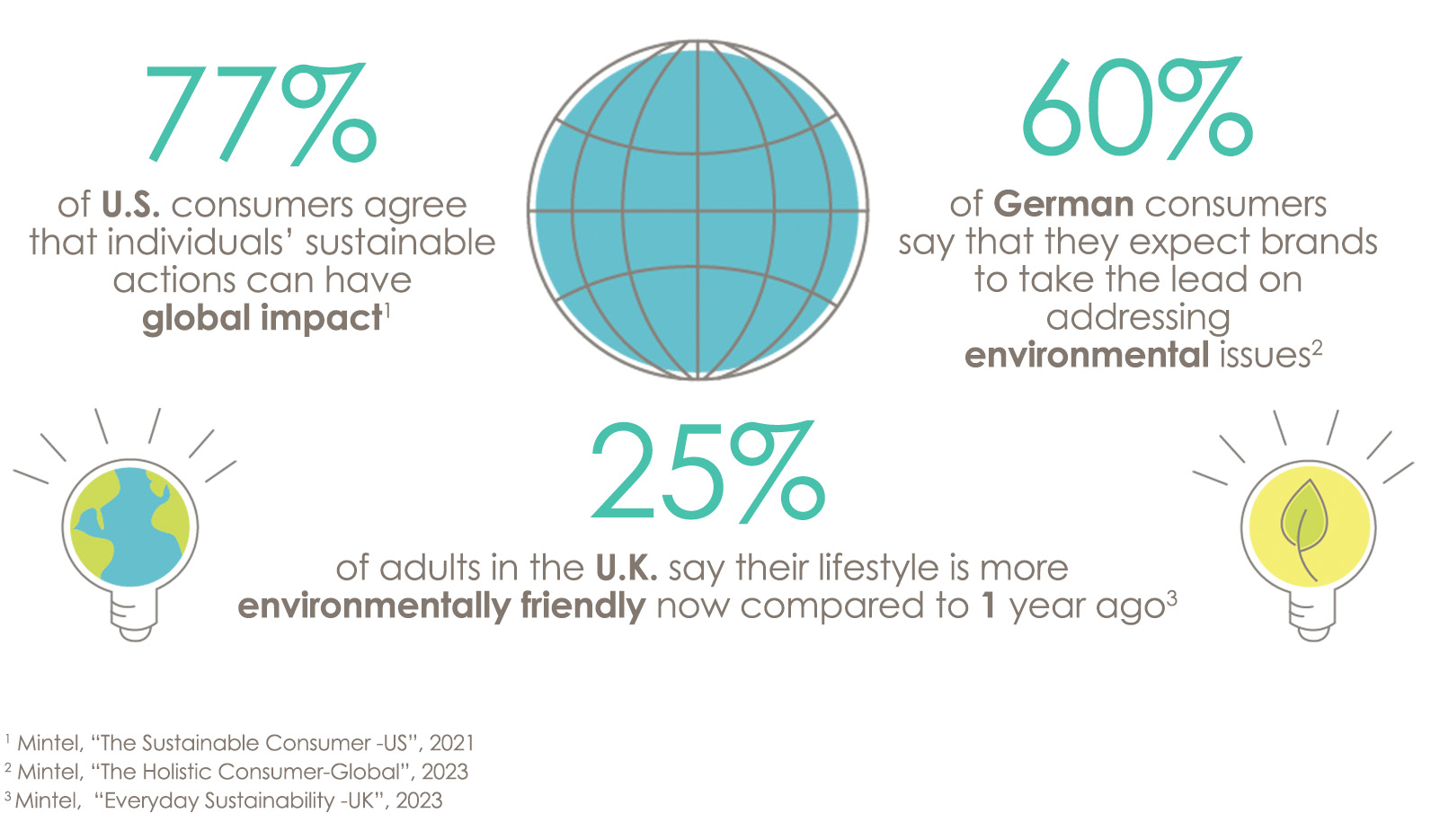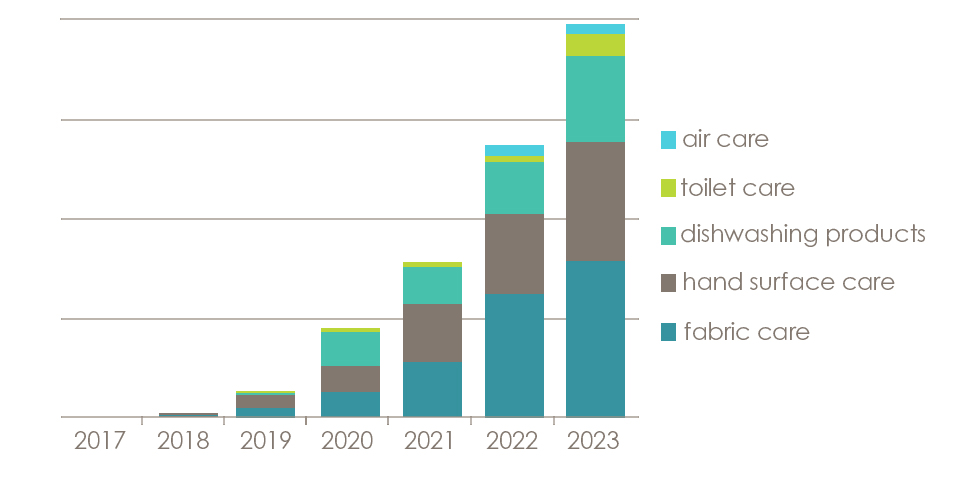who cleans without microplastics? we do.
Consumers are more inclined, according Mintel, to purchase from brands that are ethical, ecofriendly and planet positive. Consumers increasingly understand that their choices and lifestyles can impact our planet as well as expecting companies and brands to be sustainable.

There is growing awareness among consumers about microplastics. Thus, we are seeing more companies and brands looking to eliminate microplastics in their products for environmental, health and regulatory concerns.
rise in household products that mention microplastic
With the growing consumer concern with microplastics in the environment, there has been a steady growth in the number of new household care products that claim "free from microplastics," "no microplastics." "0% microplastics" or "without microplastics” (figure 1)
figure 1: global new household care product launches that make microplastic statements

source: Mintel, GNPD
ingredients for household product formulations with non-microplastic claims
We highlight below high-performance ingredients for home care formulations that can be used in to create home care formulations without intentionally added microplastic (or synthetic polymer microparticles).4
Ashland has a robust portfolio of rheology modifiers derived from sustainable wood5- and cotton6-based cellulose for thickenina a range of formulations:
- klucel™ hydroxypropyl cellulose (HPC)
- natrosol™ hydroxyethyl cellulose (HEC)

- benecel™ hydroxypropylmethyl cellulose (HPMC)

- blanose™ sodium carboxymethyl cellulose (CMC)


-
-
protect whites and colors from dye transfer with PVP K-30 or sorez™ hs-205 polymer, efficient dye transfer inhibitors that work with a range of dyes.
-
enhance cleaning with sorez™ 100 polymer, a readily biodegradable7 soil release and anti-soil redeposition polymer for synthetic and synthetic blend fabrics
-

-
- penetrate grease and tough soils for easy cleaning with surfadone™ lp-100 wetting agent, a biodegradable7 non-ionic ingredient listed on U.S. EPA Safer Chemical Ingredient List (SCIL) suitable for bathroom, glass and all-purpose cleaners. It spreads quickly and penetrates oil at very low concentrations, provides high solvency power for oils and greases, leaves no streaks or residue on surface, offers low foaming profile and is synergistic with anionic surfactants to reduce surface tension.
- rejuvenate surfaces from wear with sorez™ hs 205 polymer, a water soluble copolymer that enhances shine and masks scratches. In addition, the polymers forms a barrier that reduces the tendency of soil to adhere to surfaces offering label claims such as “easy next time cleaning” or “surfaces stay cleaner longer.”
- add vertical cling and rheology modification with natrosol™ 250 HHR HEC to toilet bowl, shower and bath cleaners.
- penetrate grease and tough soils for easy cleaning with surfadone™ lp-100 wetting agent, a biodegradable7 non-ionic ingredient listed on U.S. EPA Safer Chemical Ingredient List (SCIL) suitable for bathroom, glass and all-purpose cleaners. It spreads quickly and penetrates oil at very low concentrations, provides high solvency power for oils and greases, leaves no streaks or residue on surface, offers low foaming profile and is synergistic with anionic surfactants to reduce surface tension.

-
- remove tough foods stains for dazzling clean dishes with surfadone™ lp-100 wetting agent added to automatic dishwashing detergents. This biodegradable7, low foaming wetting agent spreads quickly and penetrates soil at very low concentrations, provides high solvency power for oils and greases, leaves no streaks or residue on surface
- create luxurious foam and improve dish cleaning with benecel™ e10m HPMC for milder hand dishwashing liquids. Nature-derived8 Benecel e10m HPMC boosts foam in dilutable surfactant systems, enhances foam and foam stability, increases formulation rheology of liquid detergents, and reduces the surfactant requirement.
- remove tough foods stains for dazzling clean dishes with surfadone™ lp-100 wetting agent added to automatic dishwashing detergents. This biodegradable7, low foaming wetting agent spreads quickly and penetrates soil at very low concentrations, provides high solvency power for oils and greases, leaves no streaks or residue on surface
4based on the CR (EU) 2023/2055 amending Annex XVII to Regulation (EC) No 1907/2006 Restriction of Synthetic Polymer Microparticles
5wood-based cellulose suppliers have made commitments to utilize standards set by the Forest Stewardship Council (FSC) and/or Program for the Endorsement of Forest Certification (PEFC).
6cotton-based cellulose suppliers have received third party certifications include the Global Recycled Standard (GRS 4.0) and SCS Recycled Content Standard, certifying that their content linters are 100% recycled content
7Has attained a sufficient level of biodegradation that meets the requirements for “ready” or “inherent” according to OECD or related methods, and/or the product has been assessed as being biodegradable based on a read-across to a chemical with similar structure, and/or the product components have been analyzed for biodegradable potential
8meets ISO 16128-2:2017 50% - 99% natural origin content standard
read more >

related literature
- home care overview guide
- benecel™ e10m HPMC sell sheet | formulating mild hand dishwashing liquids with less surfactant
- rheology modifiers for home care overview
- sorez™ 100 polymer sell sheet | enhanced cleaning efficacy of laundry products
- sorez™ hs-205 polymer sell sheet | multifunctional additive for shine, easy next time clean and surface rejuvenation
- surfadone™ lp-100 wetting agent | enhancing clean






